Tool 2 Identifying Potential Impacts
The purpose of this tool is to illustrate a step-by-step approach to identifying impacts which might arise when an element of a proposed action interacts with one or more attributes of a
World Heritage property
A cultural, natural or mixed heritage place inscribed on the World Heritage List and therefore considered to be of OUV for humanity. The responsibility for nominating a property to the World Heritage List falls upon the State(s) Party(ies) where it is located. The World Heritage Committee decides whether a property should be inscribed on the World Heritage List, taking into account the technical recommendations of the Advisory Bodies following rigorous evaluation processes.
When used as a general term, World Heritage refers to all the natural, cultural and mixed properties inscribed on the World Heritage List.
. The tool is provided as a general template to suggest one of many possible approaches, and it may be further adapted and improved as appropriate.
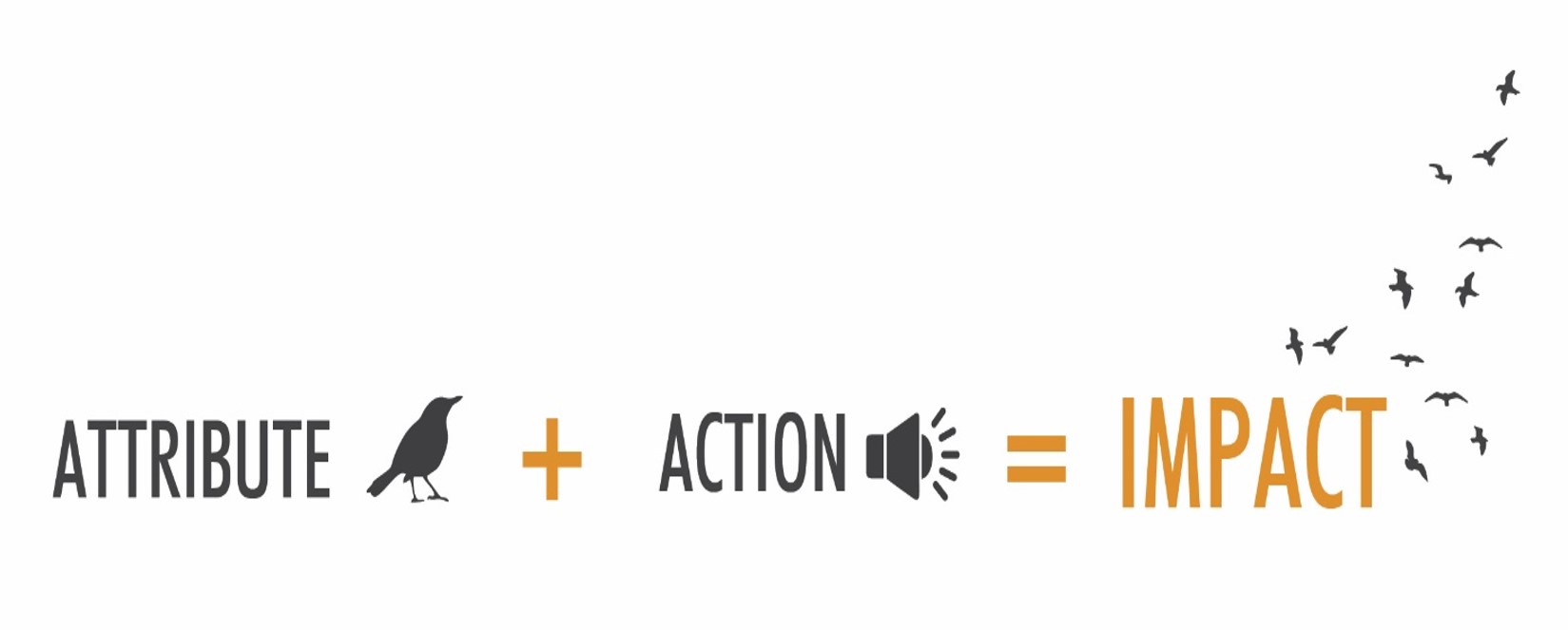
The impact on nesting birds created by noise from a proposed action. An impact is the interaction of the proposed action with an attribute of the
World Heritage property
A cultural, natural or mixed heritage place inscribed on the World Heritage List and therefore considered to be of OUV for humanity. The responsibility for nominating a property to the World Heritage List falls upon the State(s) Party(ies) where it is located. The World Heritage Committee decides whether a property should be inscribed on the World Heritage List, taking into account the technical recommendations of the Advisory Bodies following rigorous evaluation processes.
When used as a general term, World Heritage refers to all the natural, cultural and mixed properties inscribed on the World Heritage List.
. In this example, the noise from a proposed action may impact on nesting birds, which when disturbed will leave the area. Where birds are an attribute of the
World Heritage property
A cultural, natural or mixed heritage place inscribed on the World Heritage List and therefore considered to be of OUV for humanity. The responsibility for nominating a property to the World Heritage List falls upon the State(s) Party(ies) where it is located. The World Heritage Committee decides whether a property should be inscribed on the World Heritage List, taking into account the technical recommendations of the Advisory Bodies following rigorous evaluation processes.
When used as a general term, World Heritage refers to all the natural, cultural and mixed properties inscribed on the World Heritage List.
, this would lead to a loss of Outstanding Universal Value.
Tool 1
Values
In the context of heritage conservation, values are the qualities for which a heritage place is considered important to be protected for present and future generations. Values are determined by a range of social and cultural factors. What is valued by one section of society may not be valued by another, or may be valued for different reasons, or one generation may value it but it may not be valued by the next generation. Heritage places normally have a range of values: aesthetic, architectural, biological, ecological, historic, geological, social, spiritual, etc. These values are embodied in and conveyed by the attributes of the heritage place.
and attributes was designed to help identify the attributes that convey the Outstanding Universal Value of a
World Heritage property
A cultural, natural or mixed heritage place inscribed on the World Heritage List and therefore considered to be of OUV for humanity. The responsibility for nominating a property to the World Heritage List falls upon the State(s) Party(ies) where it is located. The World Heritage Committee decides whether a property should be inscribed on the World Heritage List, taking into account the technical recommendations of the Advisory Bodies following rigorous evaluation processes.
When used as a general term, World Heritage refers to all the natural, cultural and mixed properties inscribed on the World Heritage List.
. In Tool 1, the third column lists all the attributes, as shown in Table A2.1.
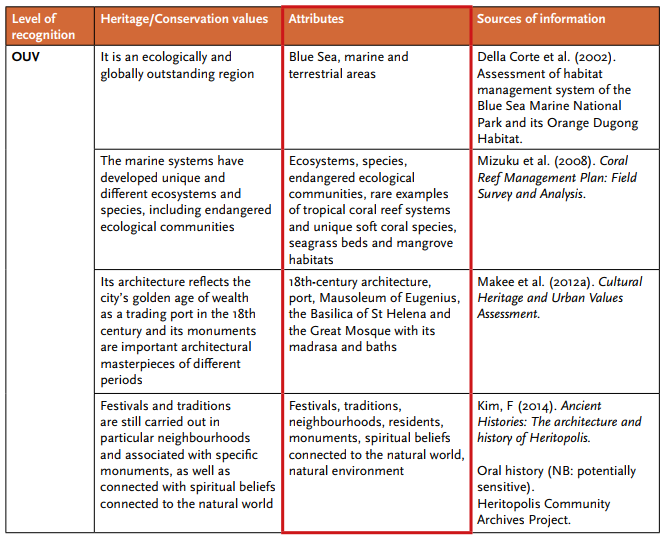
Table A2.1 Example values and attributes table
These attributes can be listed in the first column of Tool 2 (Table A2.2).
Attributes
Attributes are the elements of a heritage place which convey its heritage/conservation values and enable an understanding of those values. They can be physical qualities, material fabric and other tangible features, but can also be intangible aspects such as processes, social arrangements or cultural practices, as well as associations and relationships which are reflected in physical elements of the property.
For cultural heritage places, they can be buildings or other built structures and their forms, materials, design, uses and functions but also urban layouts, agricultural processes, religious ceremonies, building techniques, visual relationships and spiritual connections.
For natural properties, they can be specific landscape features, areas of habitat, flagship species, aspects relating to environmental quality (such as intactness, high/pristine environmental quality), scale and naturalness of habitats, and size and viability of wildlife populations.
Attributes, and the interactions between them, should be the focus of protection, conservation and management actions.
The term ‘attributes’ is particularly used for World
Heritage
All inherited assets which people value for reasons beyond mere utility. Heritage is a broad concept and includes shared legacies from the natural environment, the creations of humans and the creations and interactions between humans and nature. It encompasses built, terrestrial, freshwater and marine environments, landscapes and seascapes, biodiversity, geodiversity, collections, cultural practices, knowledge, living experiences, etc.
properties and a clear understanding of the attributes that convey their Outstanding Universal value is critical for their long-term protection. The spatial distribution of those attributes and respective protection requirements should inform the boundary of the property and other management responses.
may appear multiple times in Tool 1 but only need to be listed once in Tool 2.
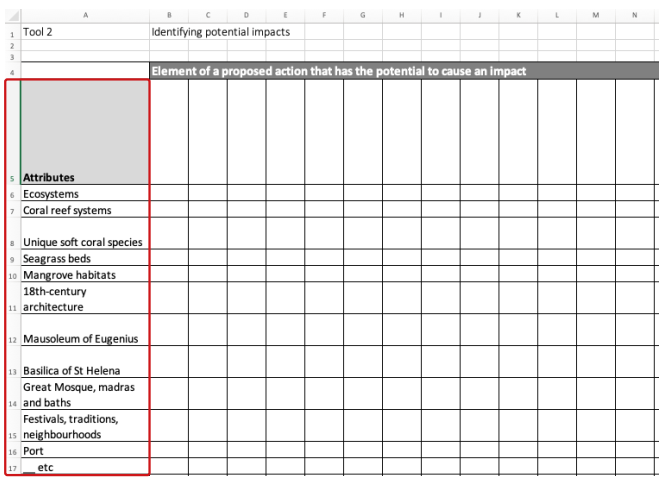
Table A2.2 Example impact identification table: Inserting the attributes
The details of the proposed action need to be understood. All stages of the proposed action should be considered – construction, operation, decommissioning, recovery – to understand exactly what will take place (directly and indirectly), how and when for the proposed action’s entire lifetime.

Stages in the life cycle of a proposed action. An impact assessment should consider the entire lifetime of a proposed action because impacts on Outstanding Universal Value might occur at any phase.
It is also important to understand if any associated actions are proposed (for example, the creation of an access road or the installation of power lines), and to assess the impacts of these as well. Likely indirect consequences of the proposed action should also be considered – for example, increased visitor numbers to a heritage place due to a new hotel complex, or the reduction of sales in traditional shops due to a new mall. However, at this stage of the impact assessment it is not necessary to evaluate if these elements of the proposed action might have positive or negative impacts: it is simply important to identify them all.
A list can be created which describes all the elements of the proposed action that might affect the
World Heritage property
A cultural, natural or mixed heritage place inscribed on the World Heritage List and therefore considered to be of OUV for humanity. The responsibility for nominating a property to the World Heritage List falls upon the State(s) Party(ies) where it is located. The World Heritage Committee decides whether a property should be inscribed on the World Heritage List, taking into account the technical recommendations of the Advisory Bodies following rigorous evaluation processes.
When used as a general term, World Heritage refers to all the natural, cultural and mixed properties inscribed on the World Heritage List.
. Some examples are provided below but the specific details of each proposed action will need to be understood.
- Demolition of buildings
- Construction of new buildings
- Construction of new access routes
- Relocation of residents
- New construction workforce
- Traffic related to site works
- Operation of new buildings
- Operation of new access routes
- New operational workforce
Once the list of elements of the proposed action has been compiled, it can then be inserted into Tool 2 (Table A2.3).
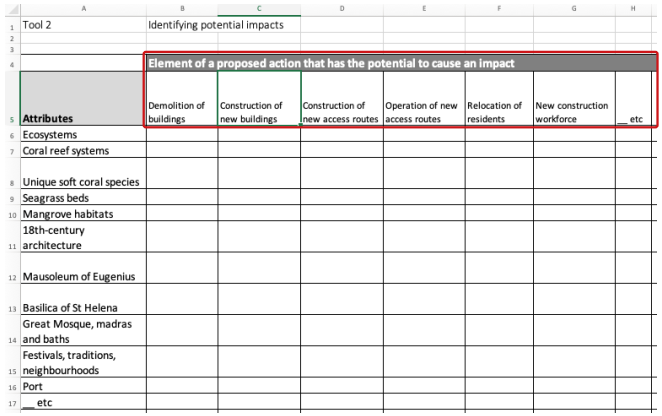
Table A2.3 Example impact identification table: Inserting the elements of the proposed action
This step involves understanding which elements of the proposed action may interact with the attributes of the
World Heritage property
A cultural, natural or mixed heritage place inscribed on the World Heritage List and therefore considered to be of OUV for humanity. The responsibility for nominating a property to the World Heritage List falls upon the State(s) Party(ies) where it is located. The World Heritage Committee decides whether a property should be inscribed on the World Heritage List, taking into account the technical recommendations of the Advisory Bodies following rigorous evaluation processes.
When used as a general term, World Heritage refers to all the natural, cultural and mixed properties inscribed on the World Heritage List.
. In some cases, there would clearly be an interaction; in other cases, maps and plans could be used to understand the precise locations of both the proposed action and the attributes. In complex cases, specialists may be needed to identify these interactions – for example, a bird specialist might be able to indicate whether the noise and disturbance caused by construction would impact on a particular species of bird during its nesting season; or whether a proposed underground train line might cause vibrations that could affect historic buildings in the area above.
Each potential interaction between an element of the proposed action and an attribute should be noted in Tool 2. This ensures that the proposed action has been systematically analysed at each stage, thereby identifying the full range of its potential impacts.
If this tool is being used at a scoping stage of an impact assessment or in preliminary analysis, then this identification of the interactions may be enough to outline the areas that will need further attention during the impact assessment process and which specialists and stakeholders might need to be involved.
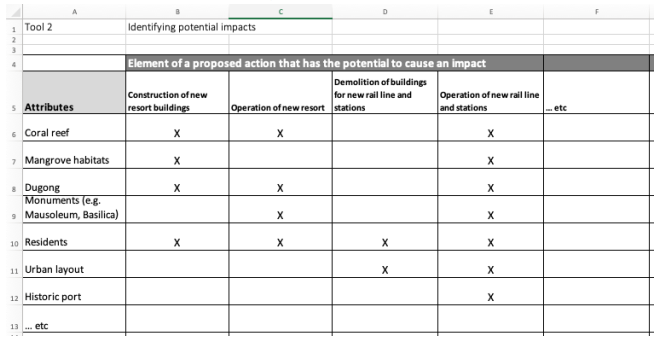
Table A2.4 Example impact identification table: Noting each potential interaction between proposed actions and attributes
Once the potential interactions between elements of the proposed action and attributes have been identified, it can be useful to begin to describe them. This allows a more sophisticated analysis of the different types of positive and negative impacts that might occur, as well as a better understanding of the specific issues that need to be investigated. Therefore, notes can be included in this table with additional details so that it serves as a summary.
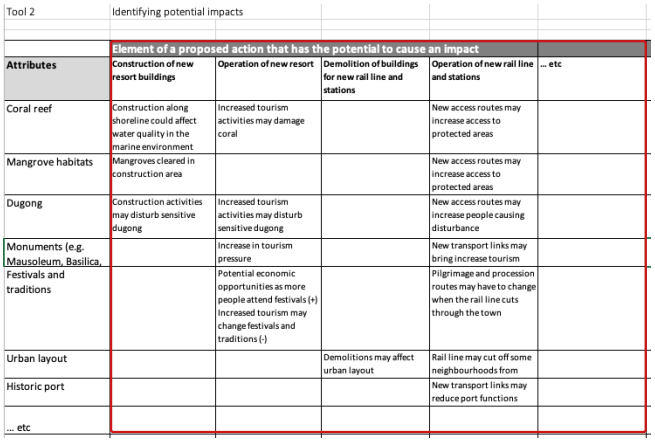
Table A2.5 Example impact identification table: More details are added for each potential impact to provide a summary of the issues that will need to be addressed in the impact assessment



